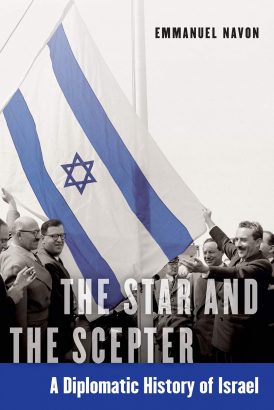The State of Israel has existed for a little over 70 years. A medium power by global standards, a superpower by Middle Eastern ones, no other country of comparable size, however measured, wields nearly as much influence on the world stage. This remarkable evolution has depended, in part, on effective diplomacy. Emmanuel Navon, an expert on international relations who lectures about Israeli foreign policy in several of the Jewish state’s universities, observes as much in The Star and the Scepter: A Diplomatic History of Israel.
This well-structured and clearly written tome does not present a comprehensive history of this diplomacy but it does examine each major foci of Israeli foreign policy across both time and space.
Navon divides his account into four sections. Rightly recognising that Israeli diplomacy has been heavily influenced by patterns of thought and modes of conduct passed down by Jewish civilisation over thousands of years, the first two sections examine the foreign policy ideas and customs inherited from this civilisation. The first section probes ideas and customs elucidated in the Hebrew Bible, especially in regard to the ever-present tension between what would later become known as ‘Realism’ and ‘Idealism’. The second section follows from the post-exilic period all the way to the modern Zionist movement.
Though Navon nicely captures the central ideas and customs of the Jewish foreign policy tradition in the first two sections, he could have linked them more explicitly to the principles and habits underlying Israeli diplomacy. To cite one example, Navon does not forthrightly address the extent to which Jewish civilisation’s prophetic tradition has shaped — or, for that matter, has failed to shape — Israeli foreign policy. To be fair, however, he does implicitly contrast the ‘hard power’ of Realism, what he calls the ‘scepter’, with the ‘soft power’ of Idealism, what he calls the ‘star’, as they have manifested themselves in Israeli diplomacy.
The third and fourth sections of Navon’s book, which together make up about three quarters of the text, concentrate on the Jewish state’s foreign policy. The third section explores the Arab-Israeli conflict. He describes and analyses how Israeli diplomacy dealt with the challenges posed by the Cold War in the Middle East; how that diplomacy attempted to outflank Arab hostility via the ‘periphery’ policy of alignment with non-Arab actors in the region; and how that diplomacy has repeatedly tried to reach accommodations with both the Arab states and the Palestinian people.
The fourth section chronicles Israeli diplomacy vis-à-vis the rest of the world. Navon surveys the Jewish state’s relationships with the US and the Soviet Union/Russia, as well as its relationships with key European, Asian, African and Latin American countries. He also examines the Israeli encounters with the UN and the Jewish Diaspora, and he dips into the area of energy diplomacy now that the Jewish state has become a serious player in this field. He might have included here a bit more commentary on Israel’s love – hate relationship with the European Union, which is going to remain a significant actor in the Middle East, regardless of whether the Jewish state wishes it to remain so.
Navon, who brings a decidedly mainstream perspective to his subject, brightly illuminates the victories obtained by, as well as the defeats suffered by, Israeli diplomacy. Taking a long-term view of these triumphs and setbacks, he argues the former has outweighed the latter by some distance.
Navon, in short, has done a first-rate job of laying out the basics of Israeli diplomacy, its sources, methods, objectives and achievements. One could not ask for a better single-volume introduction to the history of the Jewish state’s foreign policy.




































